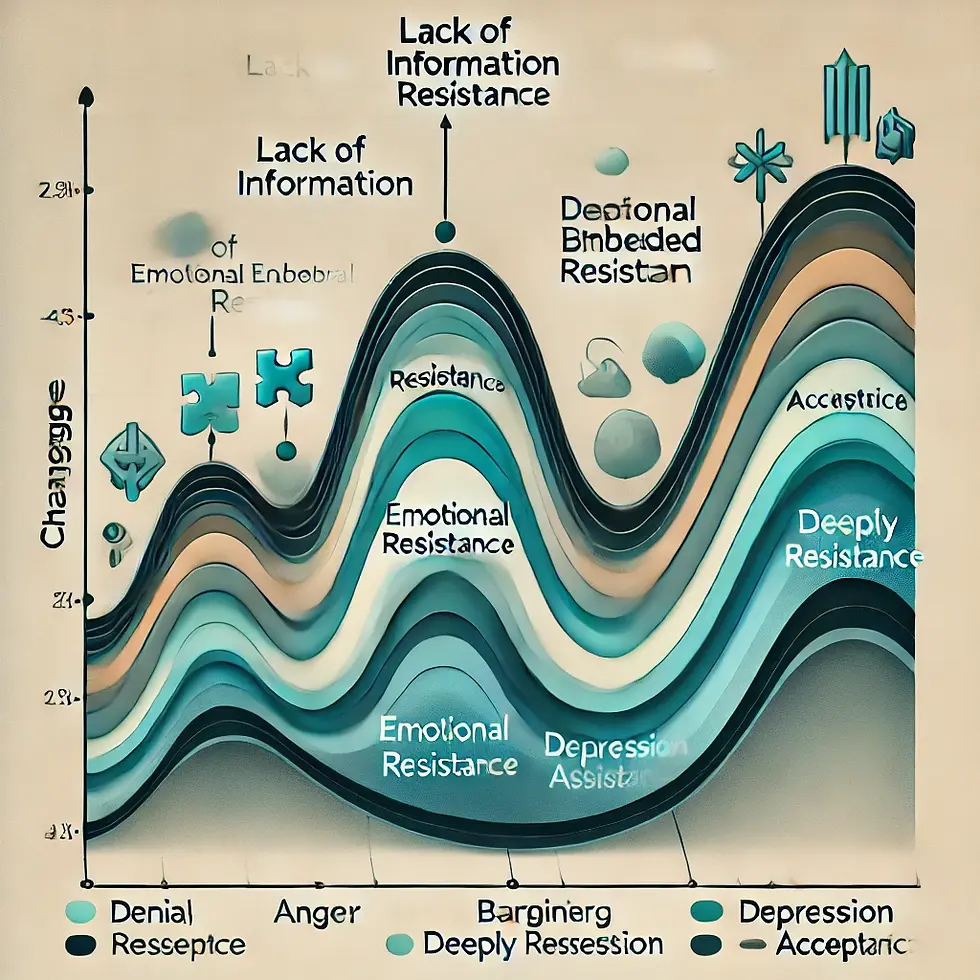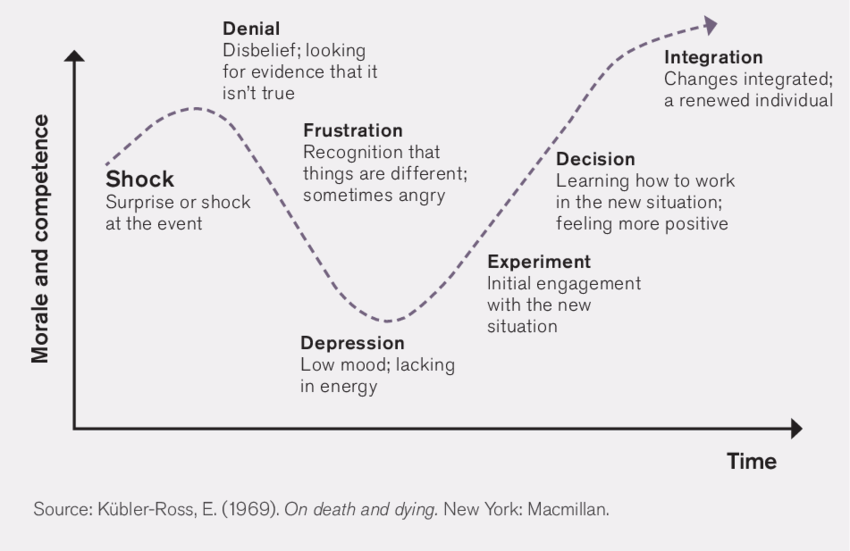Managing Resistance to Change in Organizational Transitions: Insights from Maurer’s Levels and the Kübler-Ross Change Curve
- Mzukisi Qunta
- Nov 18, 2024
- 5 min read
Updated: Nov 19, 2024
Organizational change is a constant in today’s rapidly evolving business landscape, especially in industries like engineering consultancy, construction, and digital transformation with technologies such as Building Information Modeling (BIM). Whether driven by shifts in market demands, technological advancements, or internal restructuring, change initiatives often meet resistance.

Resistance, however, is not necessarily a barrier to progress. It is a natural human reaction that, when understood and managed effectively, can serve as a valuable feedback mechanism, highlighting potential blind spots in change strategies. To better understand and address resistance to change, two key frameworks—Maurer’s 3 Levels of Resistance and the Kübler-Ross Change Curve—provide a roadmap for organizations navigating the complexities of transformation.
This article delves into these frameworks, exploring their applications in real-world scenarios. We’ll illustrate how understanding resistance can help organizations move beyond it, using examples from engineering consultancies, construction firms, and Scan to BIM businesses to showcase successes and lessons learned.
Resistance to Change: Theoretical Insights
Maurer’s 3 Levels of Resistance
Maurer’s framework identifies three escalating levels of resistance, each requiring a specific approach:
Lack of Information
At this level, resistance arises from incomplete or inadequate communication about the change. Employees may not understand the reasoning, benefits, or implications of the new direction. For instance, a construction firm transitioning to BIM might encounter skepticism from field workers unfamiliar with the technology. Without clear communication and demonstrable evidence of its benefits—such as streamlined workflows and error reduction—employees may resist adoption.
Emotional Resistance
This level delves deeper, addressing personal fears, insecurities, and distrust. Change often triggers concerns about job security, skill relevance, and career progression. For example, an engineering consultancy moving toward lean practices might encounter emotional pushback from middle managers worried about losing control or authority under flatter organizational structures.
Deeply Embedded Resistance
The most entrenched level, this resistance stems from cultural inertia and longstanding norms. It is not just about individual hesitations but reflects systemic reluctance to embrace change. A Scan to BIM firm attempting to transition from localized to global operations may find resistance rooted in its established team dynamics, where employees cling to the comfort of familiar processes.
The Kübler-Ross Change Curve
Adapted from Elisabeth Kübler-Ross’s grief model, this framework outlines the emotional stages individuals experience during change:
Denial: Employees resist acknowledging the change, dismissing it as unnecessary or impractical.
Anger: As the implications of change become evident, frustration and resentment surface, often directed at leadership.
Bargaining: Employees attempt to negotiate compromises or delay implementation, hoping to maintain the status quo.
Depression: A period of low morale as employees feel overwhelmed or helpless.
Acceptance: Employees begin to embrace the change, finding ways to adapt and thrive in the new environment.
These stages are not linear; employees may move back and forth between them depending on how the change is managed.
Integrating the Frameworks

Resistance to change is often multi-faceted, requiring a blend of strategies that address both practical concerns (Maurer’s levels) and emotional journeys (Kübler-Ross Curve).
In the context of lack of information, organizations must prioritize transparent communication. Clear messaging about the "why" behind the change is essential. For example, Trimble, a leader in advancing BIM technologies, tackled denial by organizing company-wide seminars and demonstrations. They showcased how BIM improved project outcomes, creating a shared understanding of its value.
Addressing emotional resistance requires empathy and trust-building. Construction giant Skanska faced emotional pushback during its transition to lean practices. Employees feared layoffs and diminished roles. By involving teams in co-creating lean workflows and highlighting individual contributions, Skanska mitigated fears and built a collaborative culture.
For deeply embedded resistance, long-term cultural transformation is key. This involves leadership alignment, incremental changes, and consistent reinforcement of new values. Engineering consultancy AECOM encountered this challenge while implementing agile methodologies. Middle managers resisted, viewing the shift as a threat to their authority. AECOM addressed this by training leaders to act as change ambassadors, embedding agile principles through pilot projects that demonstrated tangible success.
Lessons from Industry: Real-World Applications
Trimble: Overcoming Denial with Clear Communication
When Trimble introduced advanced BIM tools, employees in legacy roles questioned the necessity of abandoning traditional methods. To overcome denial, Trimble implemented a two-pronged approach: education and benchmarking. By organizing workshops that compared traditional workflows with BIM-enabled processes, they provided evidence of the efficiency and accuracy gains achievable through digital transformation.
Skanska: Building Trust During Emotional Resistance
In Skanska’s lean transformation journey, emotional resistance was a significant hurdle. Workers feared increased workloads and reduced autonomy. The company addressed this by fostering open dialogue and showcasing early successes, such as waste reduction and improved safety standards. These incremental wins helped rebuild trust and motivate teams.
AECOM: Shifting Organizational Culture to Combat Embedded Resistance
AECOM’s adoption of agile practices required a shift in organizational mindset, particularly among managers accustomed to hierarchical structures. Through consistent leadership training and the creation of cross-functional teams, AECOM gradually embedded agility into its culture, resulting in improved project delivery timelines and employee satisfaction.
Strategies for Success: Bridging the Gap
To navigate resistance effectively, organizations must adopt a multi-dimensional approach:
Education and Training
Resistance often stems from a lack of understanding. Investing in comprehensive training programs equips employees with the skills and confidence to embrace change. For example, in a Scan to BIM firm, training on point cloud technologies can alleviate concerns about job relevance.
Leadership and Vision
Strong leadership is critical. Leaders must articulate a compelling vision, model desired behaviors, and provide consistent support. When transitioning to digital workflows, engineering firms have successfully used champions or early adopters to lead by example, demonstrating the practical benefits of change.
Employee Involvement
Inclusive change initiatives encourage ownership and reduce resistance. Co-creating solutions, as seen in Skanska’s lean transformation, fosters buy-in and empowers employees to drive the change themselves.
Celebrating Milestones
Recognizing and celebrating achievements, even small ones, boosts morale and reinforces commitment to the change process. Acknowledging early wins helps employees see the tangible benefits of their efforts.
Continuous Feedback
Regular check-ins and feedback loops allow organizations to address concerns in real time. Open forums, surveys, and one-on-one discussions provide opportunities to identify and resolve resistance at its source.
The Emotional and Practical Dimensions of Change
Effective change management requires organizations to balance the emotional and practical aspects of resistance. While practical concerns like lack of training or unclear communication can be addressed with tools and resources, emotional resistance demands empathy, patience, and trust-building.
For example, when a construction company integrates advanced robotics for on-site operations, the emotional resistance from workers fearing obsolescence must be managed alongside training initiatives. By involving workers in the technology’s implementation and demonstrating how it enhances safety rather than replacing jobs, the company can bridge the gap between fear and acceptance.
Conclusion: Turning Resistance into Resilience
Resistance to change is not an insurmountable obstacle—it is a reflection of underlying issues that need attention. By understanding the root causes of resistance and addressing them through frameworks like Maurer’s 3 Levels and the Kübler-Ross Change Curve, organizations can transform resistance into resilience.
As industries evolve, especially those driven by technological innovation like engineering and construction, the ability to manage change effectively will determine long-term success. With clear communication, strong leadership, and a commitment to cultural transformation, organizations can navigate even the most challenging transitions, emerging stronger and more adaptable.
Are you facing resistance in your organization’s change initiatives? Let’s explore how these strategies can be tailored to your needs!
References
Kübler-Ross, E. (1969). On Death and Dying. Macmillan.
Maurer, R. (1996). Beyond the Wall of Resistance: Unconventional Strategies That Build Support for Change. Bard Press.
AECOM. (n.d.). Agile project management case studies.
Trimble. (n.d.). Advancing construction with BIM.
Skanska. (n.d.). Lean construction and cultural transformation.






Comments